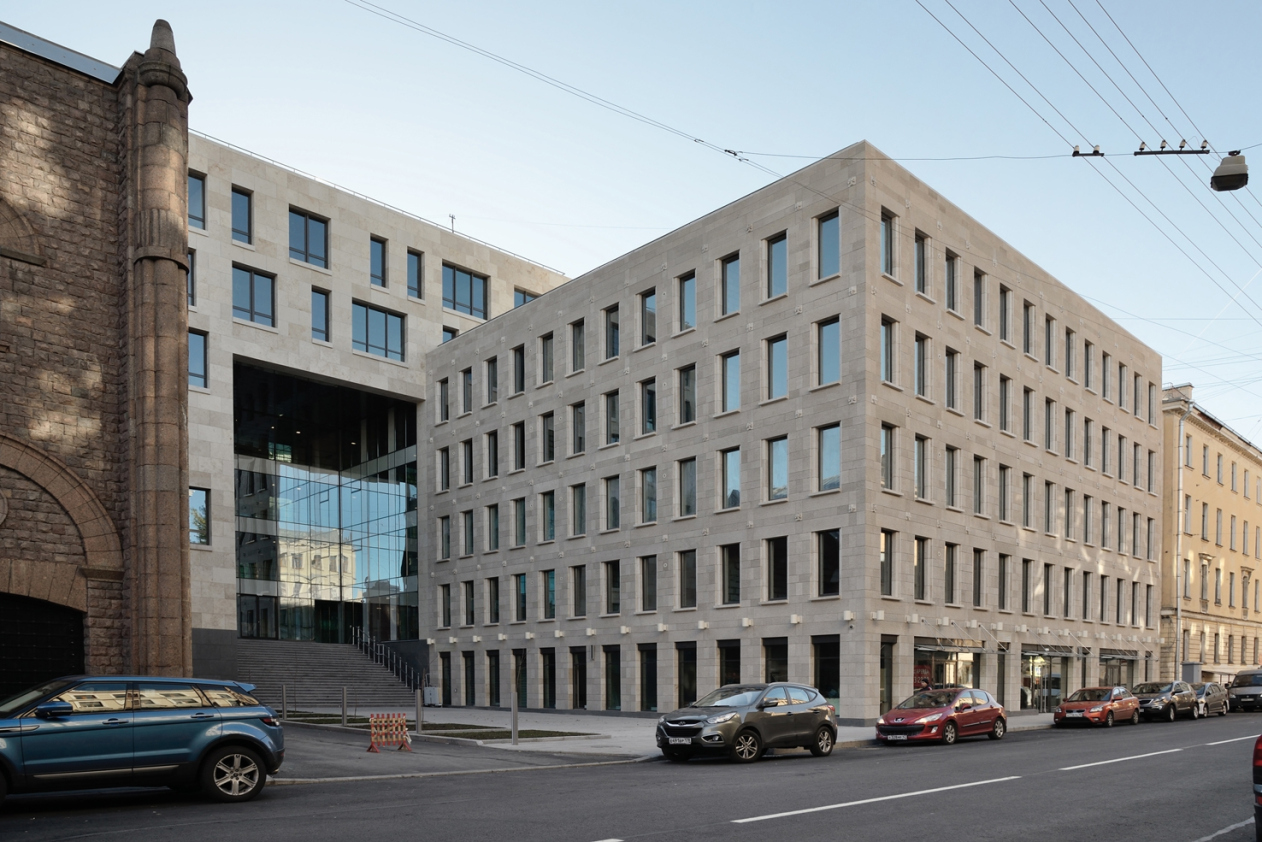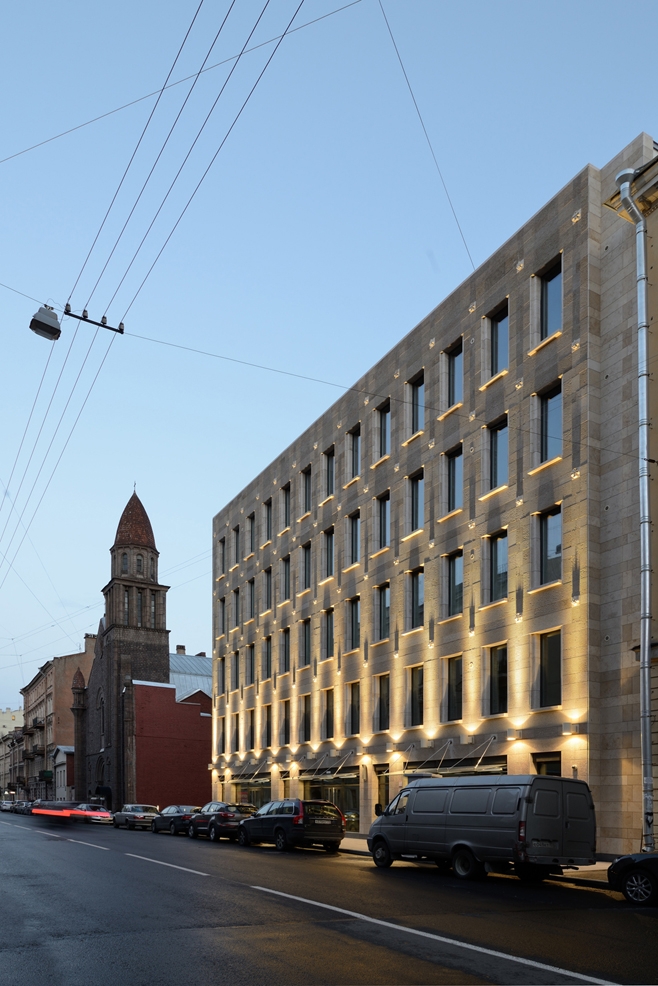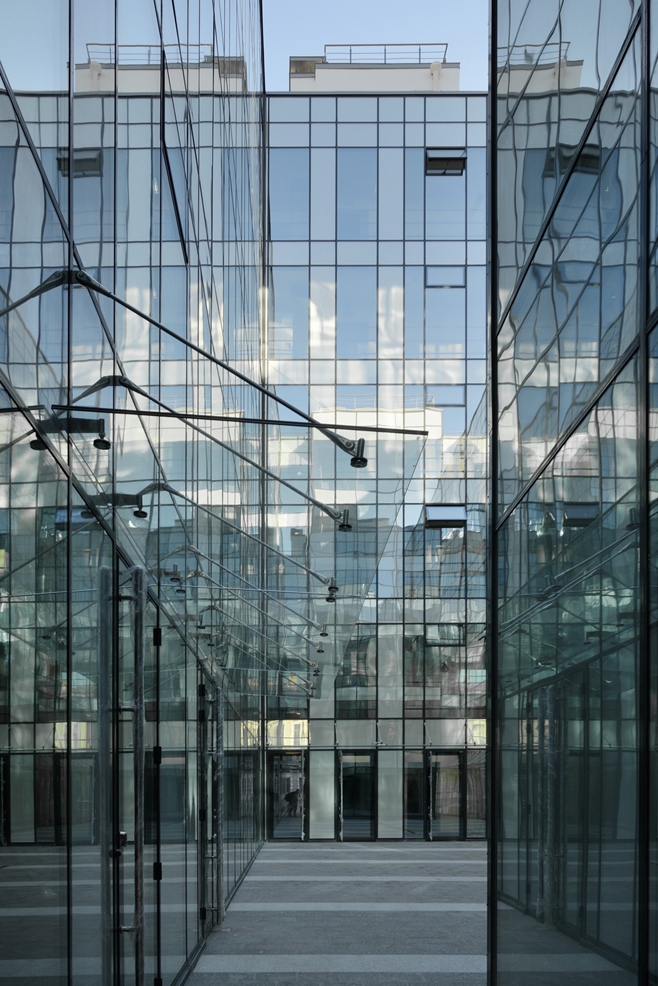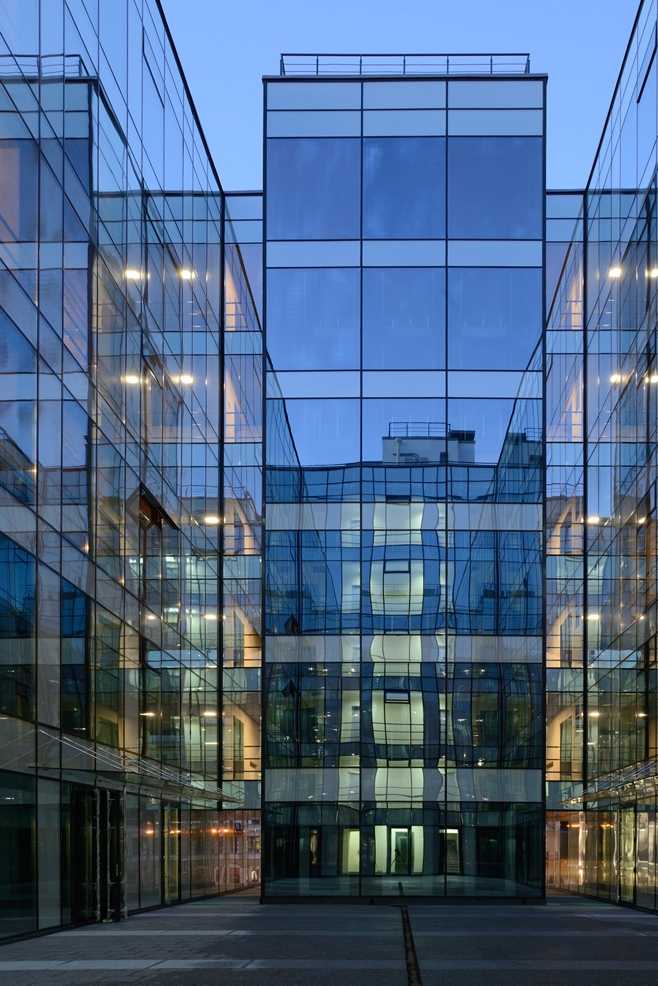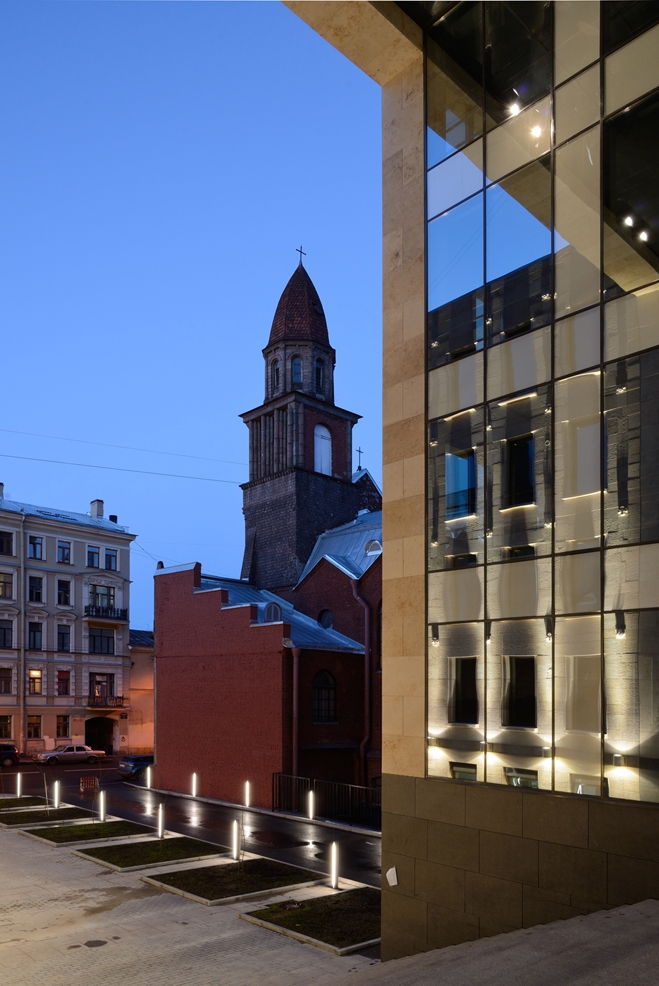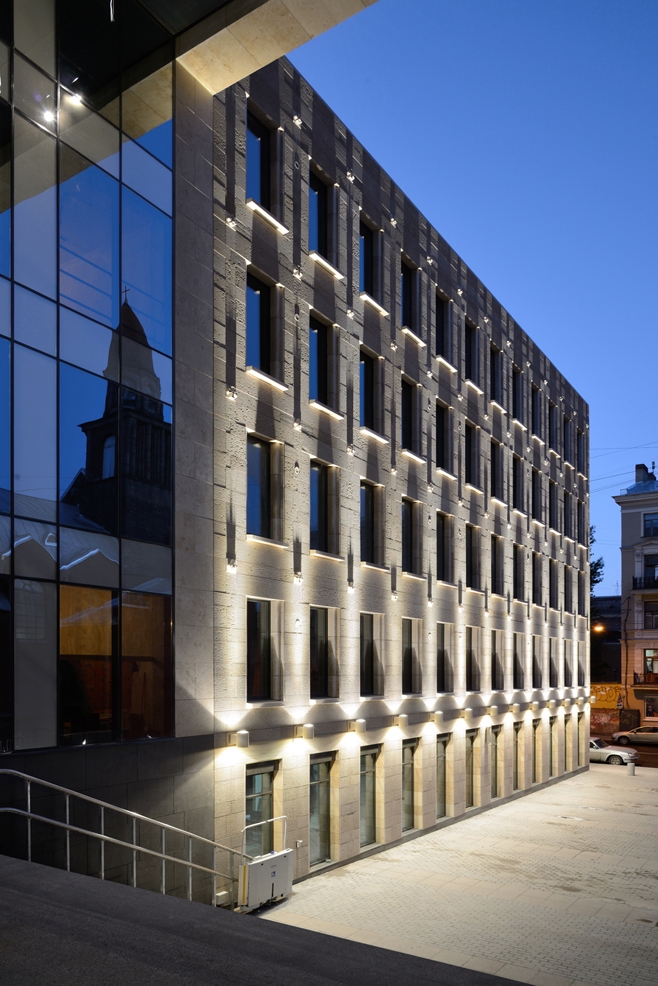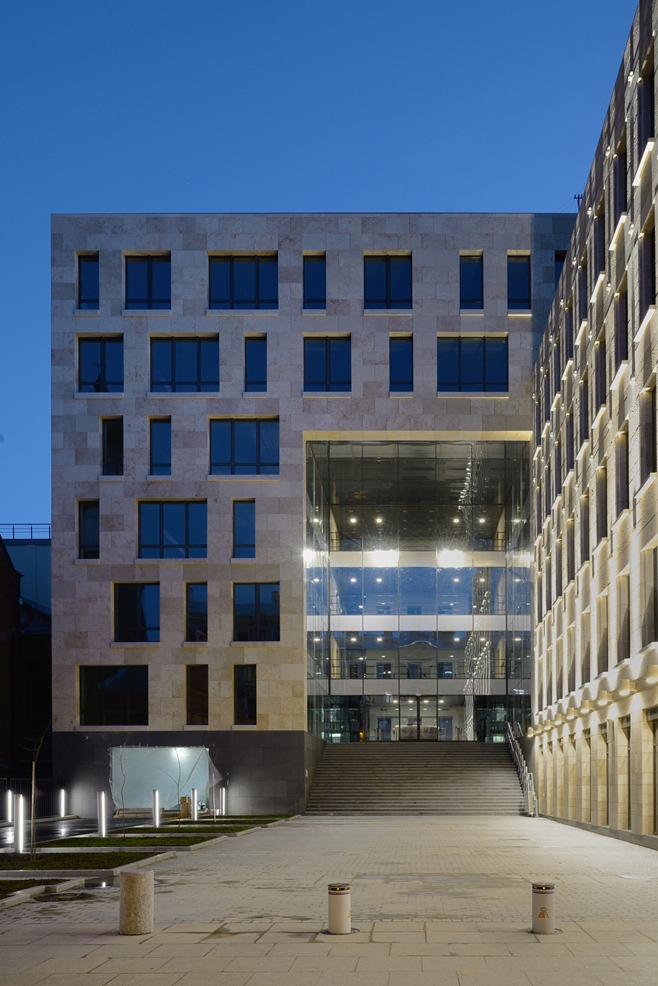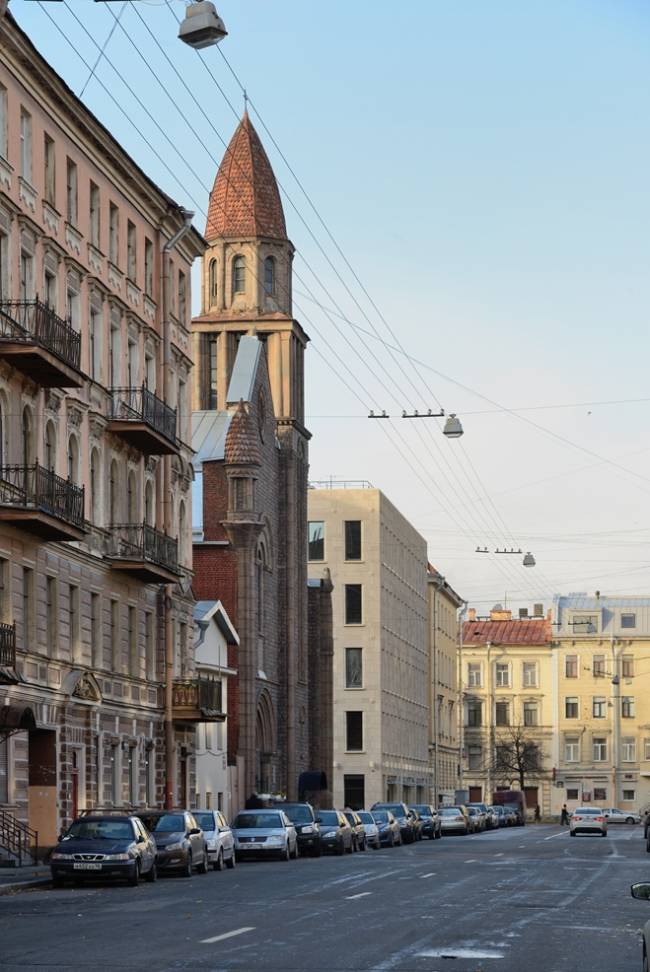
Residential house in the Kovensky Side-street © "Eugene Gerasimov and Partners"
The Kovensky Side-street is located in what can be considered not quite the "tourist" but still visitor-friendly area of Saint Petersburg, between the Liteiny and the Ligovsky avenues, in the neighborhood that is dominated by apartment houses of XIX - early XX century with an odd fraction of Stalin-era buildings. The indisputable pearl of this side-street is the church of Lady of Lourdes, a building of the early XX century with a concrete vault and a “brutalism” romantic granite facade.
The church was built in 1903–1909 upon the project of Leon Benois and Marian Peretâtkovič for the Catholic community of the French embassy. Among other things, this building is famous for the fact that under the Soviets it was the only open Catholic temple in this city.
And it was here, in the "united conservation zone" that in 2004, the construction permit was obtained, and in 2008 the construction work began. Six years ago the project looked totally different: designed by OOO "Piramida" a 9-story affair with an underground parking garage caused outrage of city-protectors and a storm of letters to the city council. After that, the project was radically redone (or, rather, made again from scratch) in Eugene Gerasimov studio. Recently, the construction was completed and, resentful of novelties of any kind though they are, the people of Saint Petersburg reacted to it with reserved acceptance: “the new house... treats its environment with tact and in a sense even complements it" - writes Konstantin Budarin in “Art 1”, approvingly noting that the author refrained from "neoclassical exercises".
If we are to speak about an example of the contemporary building, gently introduced into the tissue of a historical city, this house is a doubtless success. Eugene Gerasimov was able not only to decrease the height of the building and to move the parking garage up to the first floor level, thus avoiding the necessity of digging a construction pit amidst the historical housing, but also to put an interesting twist on the antithesis of the contemporary versus the historical, basing the architecture of his house on the almost classic for the XX century method of "marrying" the historicism and modernity - the theme that is by far the most topical for a new house built in the historical center of the city.
The red line of the side-street is faced with the residential building that at a first glance looks like it is completely made of stone. The light roughness of the Jurassic stone reacts with reserve to the "on-the-crude-side" rustication of the Benois-Peretâtkovič; the French theme is picked up by the relief inserts that are rhythmically scattered over the facade of the new house - the royal lilies and the ornamented crosses. These are responsible for the "literary" part of interacting with the context – i.e. almost literally indicate the vicinity of the French cathedral and the vision of the medieval romanticism, attributed to this place by the architects of the XX century.

Residential house in the Kovensky Side-street © "Eugene Gerasimov and Partners"
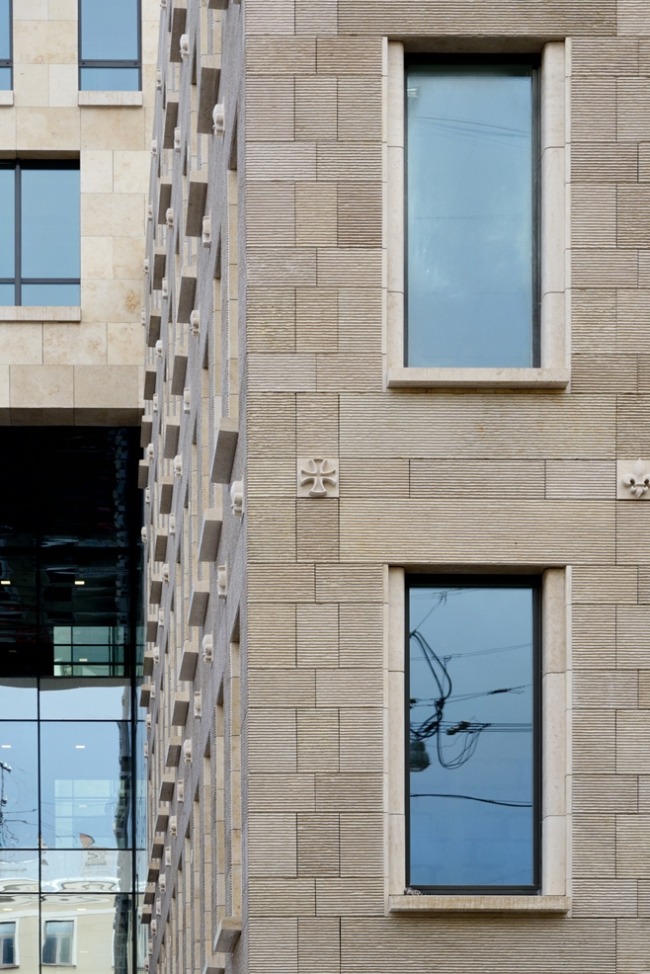
Residential house in the Kovensky Side-street © "Eugene Gerasimov and Partners"
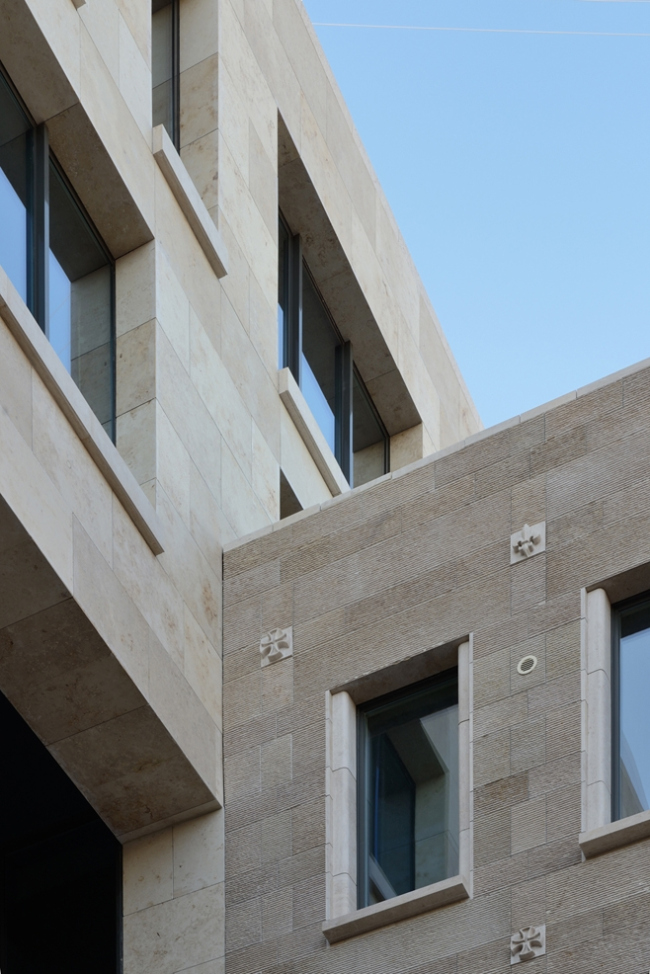
Residential house in the Kovensky Side-street © "Eugene Gerasimov and Partners"
However, the southern French theme is treated by the architects in the spirit of the XX century, which is particularly felt when one looks at the stone volume from the most advantageous North-East point, from the side of the church and the school building of the 1930's (built by David Buryshkin). Thanks to the fact that, by stepping back from the church walls, the architects made a miniature square in front of the house - not a small park, but specifically a stone-paved square, just like in Venice or maybe southern France - so, thanks to this "step-back" we see two facades of this stone volume at once. These facades are completely identical, covered with the regular network of windows with the equal partitions - which gives to the building some perfected crystalline, even metaphysical, character. There is neither firewall or major or minor facades - it is all about the strictly organized matter, an embodiment of a geometric rule. It should be mentioned here that this idea is not entirely new - in fact, it was popular in a wide range of styles from the cubic EUR of Mussolini to the thin grids of David Chipperfield (and, in particular, in the worked by Sergey Tchoban, in partnership with whom Eugene Gerasimov has recently built a few buildings).
In a word, from the northeast vantage point, the residential part of the complex looks like a perfect stone cube, with regular slits of equal-sized windows, an ideal shape that is just there in the space that, because of this vicinity, also gets a little closer to perfection. Despite the abundance of walls and the "stone-like" appearance, from the classical architecture standpoint, the building looks too much "cut-through", more like a thick stone grid than the traditional massive volume with windows. If the metaphysical Art Deco of the 1930's had thought of building something Roman, then this would have probably been the result; stylistically, this partially ties it in with the already-mentioned school building. Seemingly, the Benois Church and the Buryshkin school building are worlds apart, first of all, from the ideological standpoint. However, spiced with Art-Deco technique, the stylization let the new building find "common ground" (yes, pun intended!) with two such different neighbors. However, if we take a look at the building from the west, opposite side of the street, we will see that here it is inscribed into the line of Saint Petersburg apartment houses - this is the third subject of this architectural discourse.
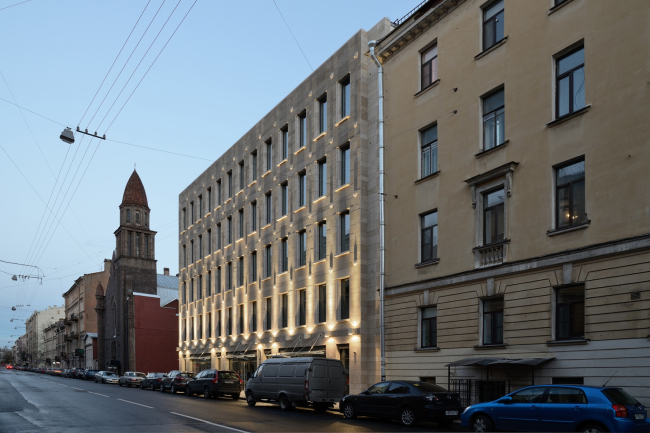
Residential house in the Kovensky Side-street © "Eugene Gerasimov and Partners"

Residential house in the Kovensky Side-street © "Eugene Gerasimov and Partners"
One can say that the residential volume that opens up to the side street's red line took up the "conservative" part of this musical piece: the textured stone, the meaningful crosses and lilies, the geometric austerity - all of this serves the context and the array of the street, rhyming with the neighboring buildings and at the same time making a contribution of its own. The "diplomat" house speaks no fewer than three languages, is reasonably conservative, moderately fit, and not devoid of speculation about the turns of history... So it comes as no surprise that such a respectable gentleman does not pass unnoticed.
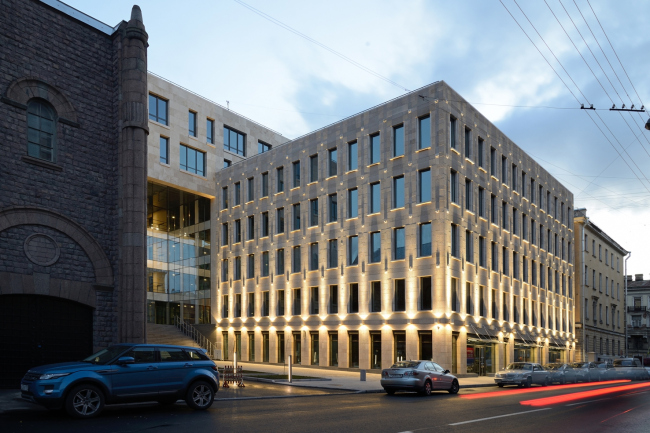
Residential house in the Kovensky Side-street © "Eugene Gerasimov and Partners"
The second volume that is there in the complex is the ultimate antithesis of the first building of "conservative upbringing". The architecture that is hidden deep inside the yard of the office part of the complex puts one in the mind of a rebel lying in wait - a glass insurgent inside the historical area of the city. The office part, of course, is not all glass - this would have been all too simple and straightforward. Its atrium courtyard, however, is all glass, and the passage into it is completely made of glass too. It is situated behind the miniature square between the already-mentioned church and the residential house and it is strung, together with this mini-square, onto one common axis, perpendicular to the line of the street. This perpendicular - the symbol of opposition - is more than appropriate here. The courtyard is opposed to the street, the glass - to the stone of the facade.

Residential house in the Kovensky Side-street © "Eugene Gerasimov and Partners"
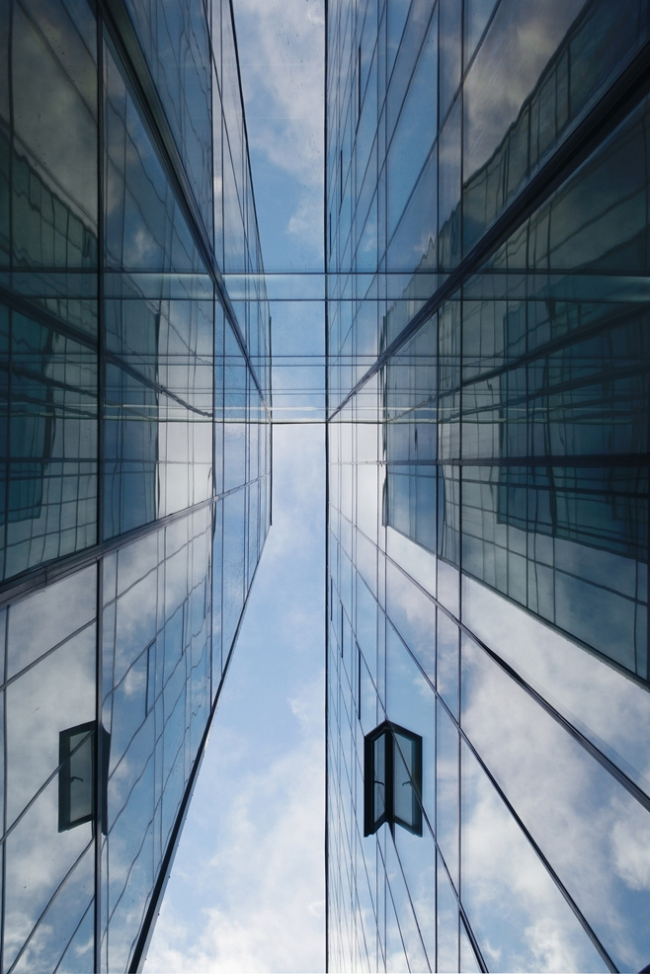
Residential house in the Kovensky Side-street © "Eugene Gerasimov and Partners"

Residential house in the Kovensky Side-street © "Eugene Gerasimov and Partners"

Residential house in the Kovensky Side-street © "Eugene Gerasimov and Partners"
However, the hi-tech matter of the future not only stands up against the traditional stone, but also lies hidden, cherishing its futuristic glass flares in the peace of the business-like yard. It even observes the city, framing, demonstrating, and admiring it. The glass corridor builds up the perspective of interaction between the two yards and the city - coming out of the pristine office glitter, we immerse into the city gradually and through the layers, as if we were going over to it through some theatric stage. The theme that is being exploited here is quite classical, and, come to think of it, it is conditioned by the circumstances. It could not be otherwise: offices are a modern thing by default, they ARE supposed to be made of glass (for lighting the workplaces, if for no other reason), but in the heart of the city the glass is not entirely welcome. The "stone" apartment house acts as the "official representative" and conducts the dialogue, while the office hides inside, which all but strengthens the energy of its glass image that, instead of the routine boredom, takes on the unexpected spectacular tension.
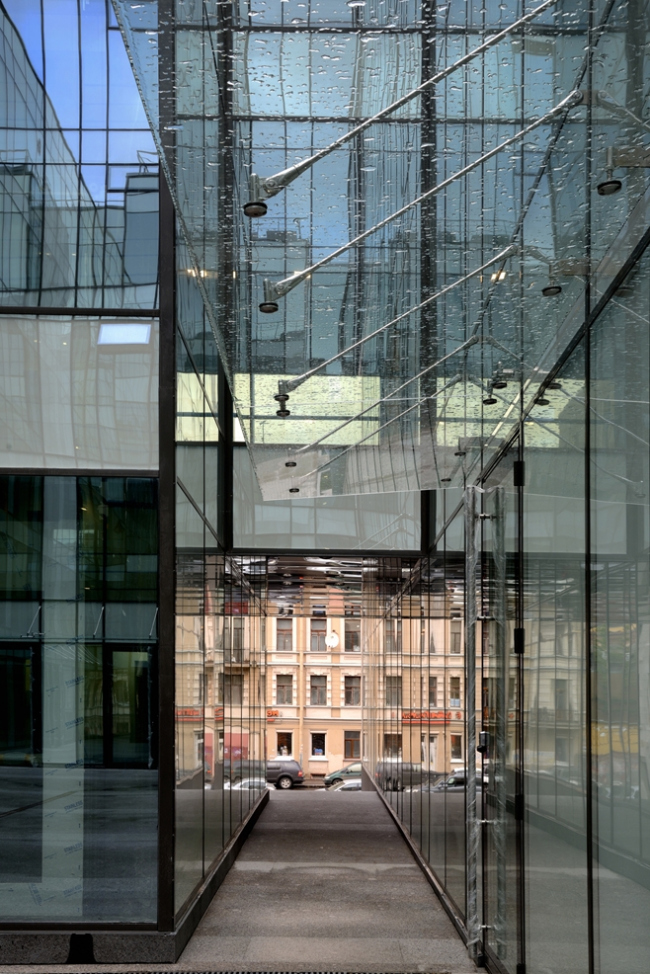
Residential house in the Kovensky Side-street © "Eugene Gerasimov and Partners"
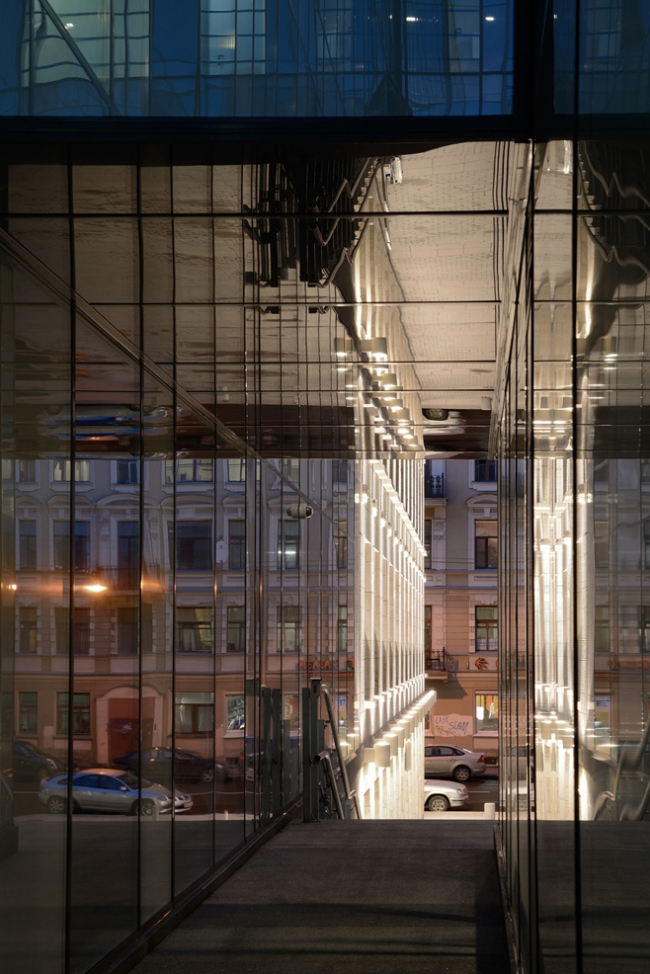
Residential house in the Kovensky Side-street © "Eugene Gerasimov and Partners"
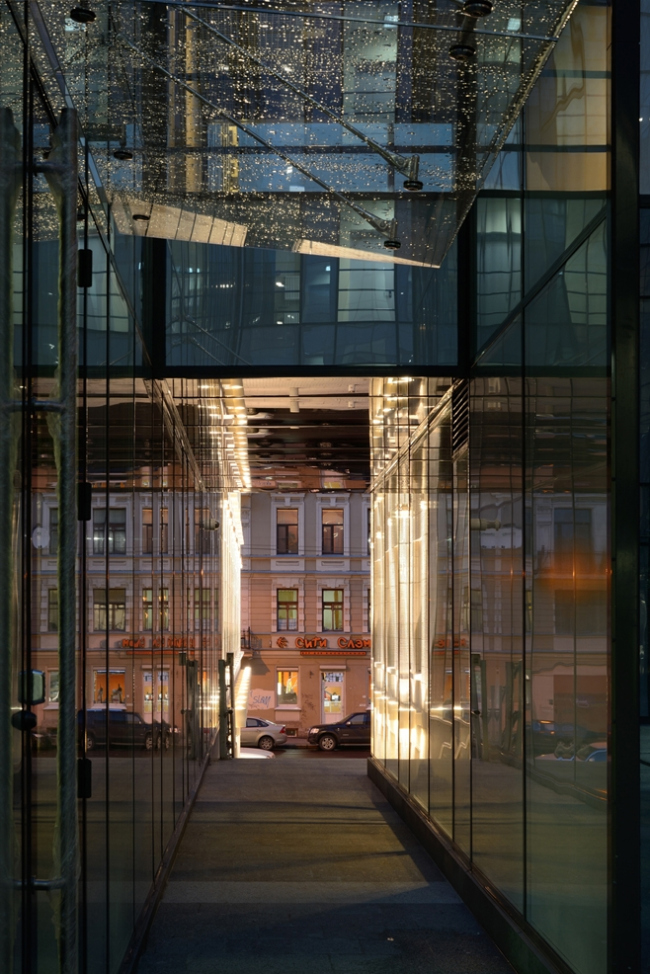
Residential house in the Kovensky Side-street © "Eugene Gerasimov and Partners"

Residential house in the Kovensky Side-street © "Eugene Gerasimov and Partners"

Residential house in the Kovensky Side-street © "Eugene Gerasimov and Partners"
But then again, there is a transition between the classical and the contemporary: as opposed to the glass atrium, the outside wall of the office part is designed in the "Holland Wall" spirit - a wall of smooth Jurassic stone with a freehand rhythm of windows. This technique, extremely popular in the 2000's and now quite overused, is still quite appropriate here because it provides the intermediate step between the rigid classical grid of the cubic volume and the totally transparent glass of the atrium. This transitional motif "joins" the two "halves" of the complex - possibly, without this "peace-making" move the architectural statement would have sounded even more dramatic, but then again, the transitional facade adds not only sophistication but also some emotional harmony to the entire design solution.
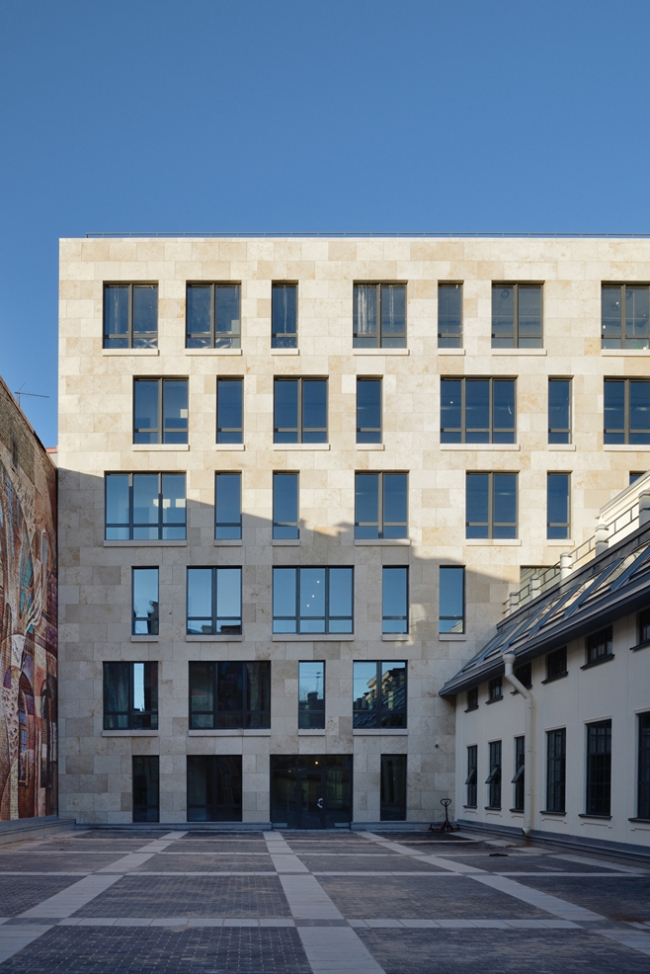
Residential house in the Kovensky Side-street © "Eugene Gerasimov and Partners"
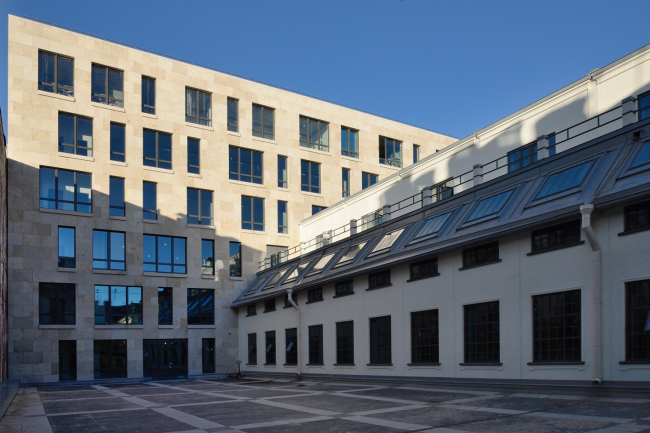
Residential house in the Kovensky Side-street © "Eugene Gerasimov and Partners"
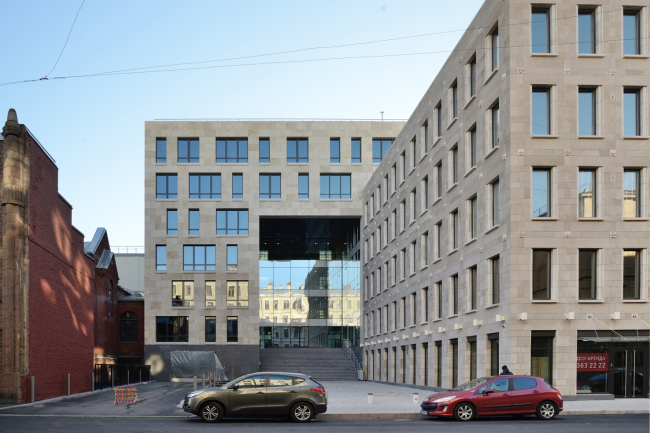
Residential house in the Kovensky Side-street © "Eugene Gerasimov and Partners"
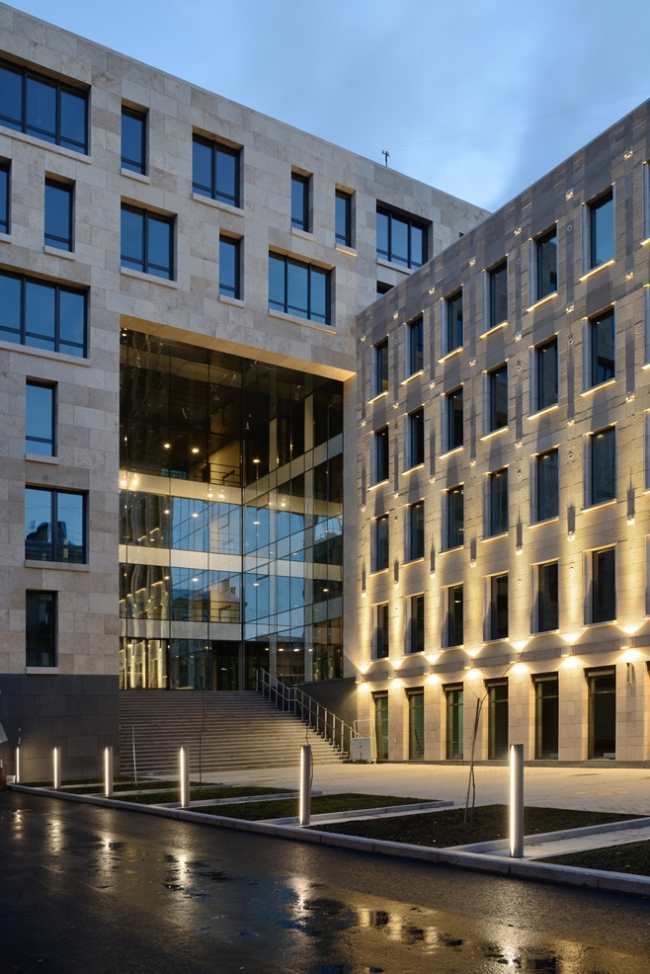
Residential house in the Kovensky Side-street © "Eugene Gerasimov and Partners"
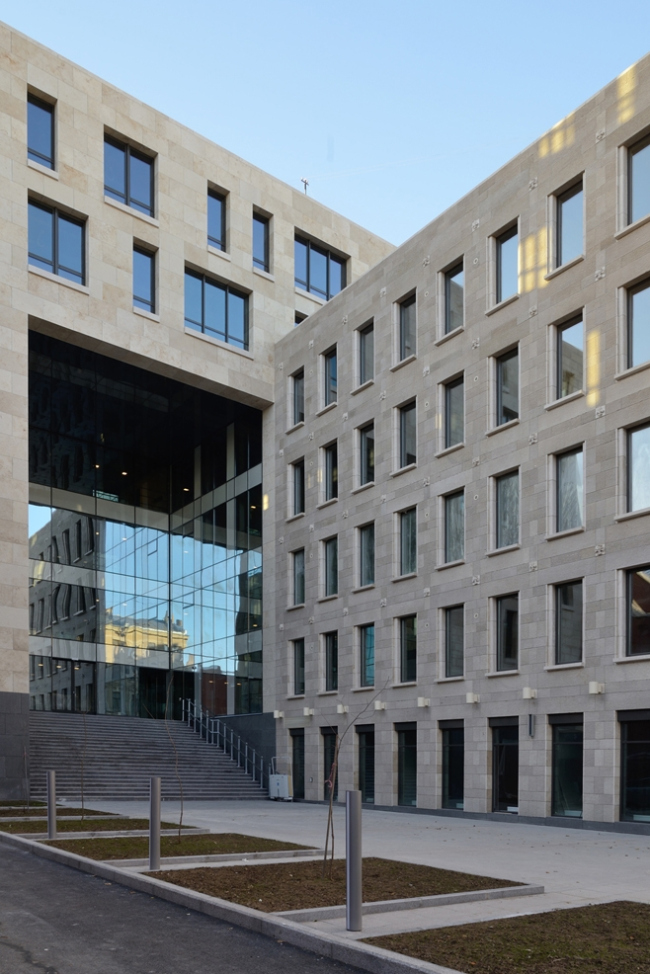
Residential house in the Kovensky Side-street © "Eugene Gerasimov and Partners"
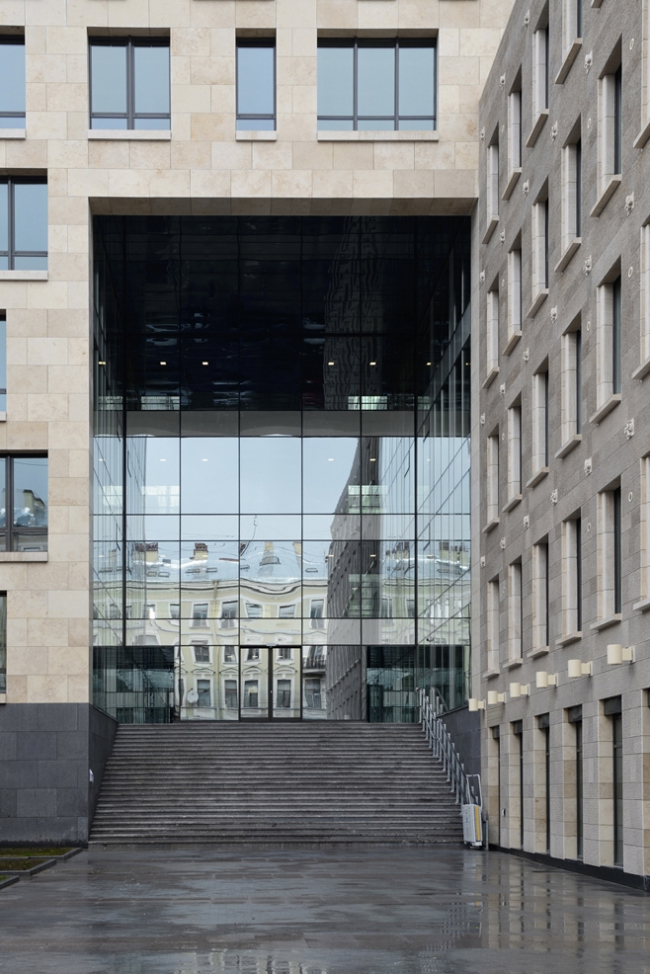
Residential house in the Kovensky Side-street © "Eugene Gerasimov and Partners"

Residential house in the Kovensky Side-street © "Eugene Gerasimov and Partners"
To the left of the new office part, i.e. directly behind the church, stands the building of the former garage of Kruemmel Company that was repaired and joined with the office building.
The garage building, built in 1909–1910, known to be Saint Petersburg's first building with intermediate floors of reinforced concrete and a flat roof, and now boasting the status of an architectural monument, also caused much controversy during the construction of "Kovensky 5". The builders tore down the four-story workshop building that had no protection status but was still, according to historian Boris Kirikov, one single whole with the garage. The demolition of the workshop building caused outrage among the Saint Petersburg city protectors: most of them mistakingly thought that it was the very garage building that got turned down, and, although the developers refuted this information, few people believed. Meanwhile, for great justice, one should recognize that the garage building is still intact, and it was the workshop that got torn down.
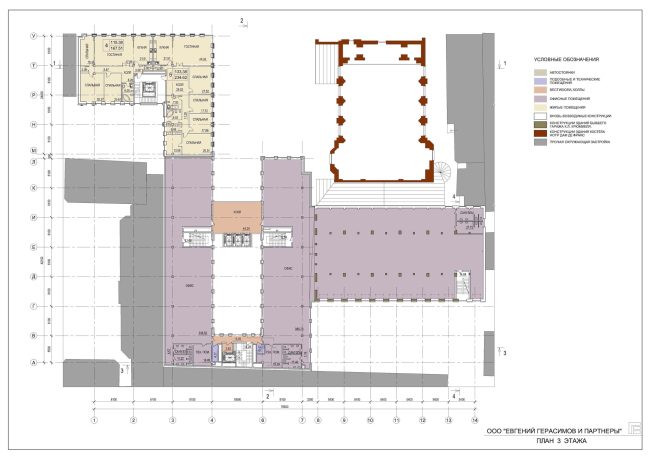
Residential house in the Kovensky Side-street © "Eugene Gerasimov and Partners"
Absorbing the garage building, the new complex literally "grew into" the historical city and became a part of it, just like the structures of the XX century did, when the difference between the history and the present day was already realized but not as acutely as today, when any intrusion into the existing architectural context is perceived as a serious offence. Meanwhile, the interaction between the old, the new and the stylized began in the Kovensky Side-street not ten, but a hundred years ago. The church with it "technologically advanced" concrete vaults and the Roman facade, and the garage with the city's first flat roof on slender supports - back in the day they were quite cutting edge (just think what would the city protectors would have said TODAY if somebody had started building a parking garage right behind the altar?) Eugene Gerasimov's building picks this thing up and takes it to a new level, makes the controversy still more acute, and continues the dialogue - which allows it, for all its delicacy, to avoid being left unnoticed and downtrodden by the context but to be a fully-fledged - meaning a "living" - part of the city.
The residential house in the Kovensky Lane
Copyright: © Evgeniy Gerasimov & Partners

